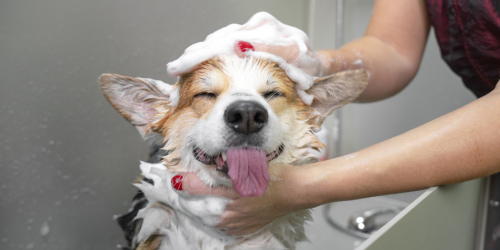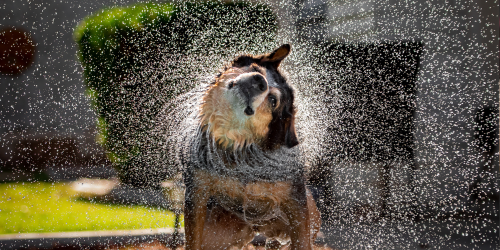
How Often Should You Shower Your Dog?
Keeping your furry friend clean and fresh is an essential part of responsible pet ownership. Regular bathing not only helps maintain your dog’s hygiene but also promotes their overall health and well-being. However, determining the optimal frequency of dog showers can be a challenge, as it depends on various factors such as breed, coat type, activity level, and skin condition. In this article, we will explore the factors to consider and provide guidelines to help you determine how often you should shower your dog.
Factors To Consider Before Showering Your Dog
Breed
Different dog breeds have different grooming needs. Breeds with longer hair, such as Shih Tzus or Yorkshire Terriers, may require more frequent bathing to prevent matting and keep their coats clean. On the other hand, breeds with shorter hair, like Boxers or Labradors, may need fewer baths. Research your dog’s breed to understand their specific grooming requirements. You need to choose the best for showering your pet as well.
Coat Type
The type of coat your dog has is a crucial factor in determining bathing frequency. Dogs with oily coats, such as Basset Hounds or Dachshunds, may need more frequent bathing to manage their natural oil production. Conversely, breeds with dry skin, like Bulldogs or Greyhounds, may require less frequent bathing to prevent stripping their skin of essential oils.
Activity Level
Dogs that are highly active or frequently outdoors may get dirtier more quickly and require more frequent baths. If your dog enjoys rolling in the mud, swimming, or exploring nature, you may need to bathe them more often to keep them clean and odor-free.
Skin Condition
Dogs with specific skin conditions, such as allergies or dermatitis, may require more frequent bathing as part of their treatment plan. The diet you provide to your dog plays a crucial role in maintaining their skin health. If your dog is experiencing skin sensitivities, it’s worth considering Annamaet Sensitive Skin and Stomach.
However, it’s important to consult with your veterinarian before establishing a bathing routine for dogs with skin issues to ensure you’re using appropriate products and methods. They may recommend specialized shampoos or conditioners suitable for your dog’s specific needs.
General Guidelines
While the factors mentioned above influence the frequency of dog showers, there are some general guidelines you can follow:
Monthly Baths
As a starting point, most dogs benefit from a monthly bath. This time frame allows enough time for your dog’s natural oils to replenish, maintaining their coat’s health and shine.
Odor and Dirt
Pay attention to your dog’s odor and the level of dirt accumulated on their coat. If your dog has a noticeable odor or is visibly dirty, it may be time for a bath even if it’s before the monthly mark.
Sensory Evaluation
Give your dog a good sniff test. If they smell clean and fresh, they may not require a bath just yet. However, if their coat has a strong or unpleasant odor, it’s an indication that bathing is necessary.
Skin and Coat Condition
Regularly check your dog’s skin and coat for any abnormalities or signs of dryness. If their skin appears healthy and their coat is shiny and free from tangles or mats, you’re likely on the right track with your bathing routine.

Tips for a Successful Dog Bathing Experience
Preparation
Before bathing your dog, gather all the necessary supplies, such as dog shampoo, towels, and a brush or comb. Ensure you have a safe and appropriate bathing area ready, with non-slip mats or a tub lined with a towel to provide stability and comfort for your dog.
Water Temperature
Use lukewarm water to make the bathing experience comfortable for your dog. Water that is too hot or too cold can cause discomfort or stress.
Appropriate Products
Use dog-specific shampoos and conditioners that are formulated for your dog’s coat type and skin condition. Human shampoos can be too harsh and may irritate your dog’s skin.
Gentle Washing Technique
Wet your dog thoroughly, avoiding their eyes and ears. Apply the shampoo and massage it into their coat gently, making sure to cover all areas. Rinse thoroughly to remove all the shampoo, as residue can cause skin irritation.
Drying and Brushing
Use towels to remove excess water from your dog’s coat, and then allow them to air dry or use a blow dryer on a low, cool setting. Brush their coat gently to prevent matting and distribute natural oils.

Maintaining Skin Health Between Baths
In addition to regular baths, there are a few practices you can incorporate into your dog’s grooming routine to maintain their skin health:
Regular Brushing
Regular brushing helps remove loose hair, debris, and tangles from your dog’s coat. It also stimulates blood circulation and distributes natural oils, promoting a healthy coat. Use a brush or comb suitable for your dog’s coat type to prevent discomfort or damage.
Spot Cleaning
In between baths, spot cleaning can be useful for keeping your dog clean. Use pet-friendly wipes or a damp cloth to clean their paws, face, and other areas prone to dirt accumulation. This helps remove surface dirt and keeps them fresh between baths.
Dry Shampoos
Dry shampoos formulated for dogs can be a convenient option for freshening up your dog’s coat between baths. They absorb excess oil and odors, making your dog smell clean without the need for water. However, they should not replace regular baths and should be used as a temporary solution when bathing is not feasible.
Conclusion
Maintaining your dog’s cleanliness and skin health through regular baths is essential for their overall well-being. By considering factors such as breed, coat type, activity level, and skin condition, you can establish an appropriate bathing routine that promotes their health and comfort. Remember to use dog-specific grooming products, be mindful of water temperature, and provide a positive bathing experience for your furry friend. While baths are important, also focus on regular brushing and spot cleaning to keep your dog clean between baths. Monitor your dog’s skin and coat condition, and consult with your veterinarian for personalized guidance and recommendations. With proper care and attention, you can ensure that your dog stays clean, healthy, and happy.
